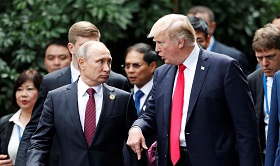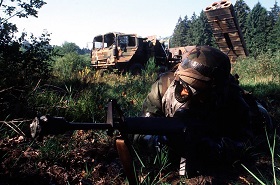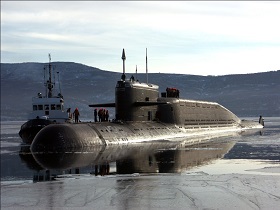Do we really still need all these distinctions between strategic, intermediate-range and tactical systems? The reality is that the United States and Russia have and will continue to have strikingly different geopolitical and geostrategic positions in the world; their threat perceptions and their respective strategic doctrines will never be identical. If so, could we merge New Start and INF into one umbrella agreement, which would set overall ceilings for nuclear warheads and launchers on both sides?
Within these overall ceilings, both Washington and Moscow would be in a position to blend individual cocktails of strategic, intermediate range and tactical systems to their liking. For a better taste, they could even add the missile defense component to the mix; there is no particular reason why BMD should not be a part of the drink. As some U.S. and Russian experts argue, the only sub-ceiling that we might need to preserve is the sub-ceiling for deployed warheads, which are of particular concern to the other side. This sub-ceiling can amount to a half or one third of the total number. In other words, the cocktail should be shaken, but not stirred.
In the aftermath of the 2016 presidential election, the enmity between the U.S. and Russia has reached new highs. However, the intense heat generated by the current Trump–Russia scandal as well as U.S.–Russia tensions over Ukraine and other hot spots risks blinding us to the fact that Russia–U.S. cooperation on nuclear arms control is still very much in both sides national interests'. Indeed, the Bulletin of Atomic Scientists' moved its so-called "Doomsday Clock" to two and a half minutes to midnight, meaning the threat of nuclear war is now the highest it’s been since 1953.
It’s not difficult to see how a catastrophic nuclear incident between Russia and the U.S. could occur. Since the beginning of the Ukrainian crisis, NATO–Russia military-to-military communication in Europe and the strategic dialogue between Moscow and Washington have come to a halt. One of the most serious challenges looming on the horizon is a complete and irreversible disintegration of the bilateral nuclear arms control regime that has been the rock hard foundation of the global strategic stability for almost half a century.
Many scholars, diplomats and military experts on both sides of the Atlantic are desperately searching ways to preserve this regime. Two specific tasks are regarded as the most urgent — to salvage the Intermediate Nuclear Forces (INF) Treaty and to extend the New Start Treaty beyond its expiration date in early 2021. The first task appears to be more difficult, close to impossible now — both sides publicly accuse each other of violating INF, and influential political groups on both sides question the value of the agreement. However, we should not take the extension of New Start for granted either as President Trump demonstrated little appreciation of arguably one of the most significant accomplishments of the Obama Administration. Besides, should INF fall, New Start would be much more difficult to extend.
The goal to preserve INF and New Start is definitely worth fighting for. Nevertheless, even if this hard battle is won, this will not signal the end of the war to secure and to strengthen strategic arms control in the 21 st century. Although there is a distance of twenty-three years between INF (1987) and New Start (2010), both agreements reflect the logic of the Cold War, both are based on the strategic culture acquired by Washington and Moscow in late 1960s – early 1970s. With a stretch of imagination, one might argue that both agreements could have been signed by Richard Nixon and Leonid Brezhnev. Either treaty includes no points that would address problems of missile defense, tactical nuclear weapons, space-based weapons, cyber warfare, third nuclear countries, nuclear terrorism or prompt global strike capabilities.
Moreover, neither INF, nor New Start prevents the United States from spending USD 1 trillion in the next 30 years on modernizing its nuclear bombs, bombers, missiles and submarines. Russia will also continue its large-scale strategic modernization program, even if the two agreements remain in place.
The crisis of strategic arms control is more complex and fundamental than the uncertain future of the two agreements, as important as they are. In the 21st century, strategic arms control is no longer about arithmetic; it requires application of advanced mathematics. These days, mobility dominates over location, precision beats through weight; the borderline between nuclear and conventional weapons gets almost invisible. The old arms control got into its ‘perfect storm’ and though the preservation of the Cold War heritage is indispensable, preservation per se is clearly not sufficient to provide for strategic stability in a completely new global environment.
Do we really still need all these distinctions between strategic, intermediate-range and tactical systems? The reality is that the United States and Russia have and will continue to have strikingly different geopolitical and geostrategic positions in the world; their threat perceptions and their respective strategic doctrines will never be identical. If so, could we merge New Start and INF into one umbrella agreement, which would set overall ceilings for nuclear warheads and launchers on both sides?
Within these overall ceilings, both Washington and Moscow would be in a position to blend individual cocktails of strategic, intermediate range and tactical systems to their liking. For a better taste, they could even add the missile defense component to the mix; there is no particular reason why BMD should not be a part of the drink. As some U.S. and Russian experts argue, the only sub-ceiling that we might need to preserve is the sub-ceiling for deployed warheads, which are of particular concern to the other side. This sub-ceiling can amount to a half or one third of the total number. In other words, the cocktail should be shaken, but not stirred.
This approach will not address all the contemporary challenges to strategic arms control. For example, it will not multilateralize the latter, though the time has come to move away from a bilateral Russia–U.S. format to a multilateral one. Still, an innovative approach would be a loud and clear signal to third nuclear powers, demonstrating Moscow’s and Washington’s will not only to preserve, but also to enhance and to modernize global strategic security.
Sceptics can argue that today is not the best time to experiment with new approaches to strategic arms control. The Russia–U.S. hit historical lows, the trust between the two countries is nonexistent, political opposition to any new deals will be too strong to generate domestic support for any new agreements. These are exactly the arguments they used back in 1950s against a possible U.S.–Soviet collaboration in writing a set of rules for the new nuclear world. It took the Cuban missile crisis of October 1962 to start moving away from this perception and another ten years to sign the first U.S.–Soviet Strategic Arms Limitation Talks Agreement (SALT-1). Are we ready to wait for another missile crisis — in North Korea or elsewhere? Can we afford another ten years for a new détente between Washington and Moscow?







